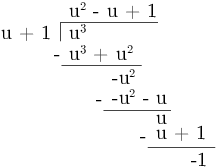In this section, I'll look at some other integration techniques.
Completing the square.
When an integral contains a quadratic expression ![]() --- that is, a quadratic with
a middle term
--- that is, a quadratic with
a middle term ![]() --- you can sometimes
simplify the integrand by completing the
square. This eliminates the middle term of the quadratic; the
resulting integral can then be computed using (e.g.) trig
substitution.
--- you can sometimes
simplify the integrand by completing the
square. This eliminates the middle term of the quadratic; the
resulting integral can then be computed using (e.g.) trig
substitution.
Example. Compute ![]() .
.
Since ![]() and
and ![]() , I have
, I have
![]()
Therefore,
![]()
![]()
![]()
Example. Compute ![]() .
.
Since ![]() and
and ![]() , I have
, I have
![]()
Therefore,
![]()
![]()
Next, I need a trig substitution:
![]()
![$$\hfil\raise0.5in\hbox{$\left[x = 3 \sec \theta, \quad dx = 3 \sec \theta \tan \theta\,d\theta\right]$} \hskip0.5in \hbox{\epsfysize=1in \epsffile{miscellaneous-integration-techniques-1.eps}}\hfil$$](miscellaneous-integration-techniques17.png)
![]()
![]()
Note that in some cases, an integral containing a quadratic with a
middle term can be integrated in other ways. For example, in this
integral I can let ![]() :
:
![]()
This integral can be done using partial fractions:
![]()
Fractional powers.
When an integral contains fractional powers ![]() , you can often simplify the
integrand using a substitution of the form
, you can often simplify the
integrand using a substitution of the form
![]()
Take k to be the least common multiple of the denominators of the fractions that occur in the exponent.
Example. Compute ![]() .
.
Since the least common multiple of the denominators 3 and 4 is 12,
I'll use ![]() :
:
![]()
![]()
Since the top has a higher power than the bottom, I do a long division:

This gives
![]()
Hence, my integral is
![]()
![]()
Example. Compute ![]() .
.
Since the least common multiple of the denominators 2 and 5 is 10,
I'll use ![]() :
:
![]()
![]()
![]()
Example. Compute ![]() .
.
The idea here is the same as in the last two examples: I can eliminate a square root by putting a square inside.
![]()
![]()
![]()
Example. Compute ![]() .
.
Let ![]() , so
, so ![]() . I get
. I get
![]()
I'll do this integral by parts:

I do the parts computation and put the x's back using ![]() (since
(since ![]() ):
):
![]()
Copyright 2019 by Bruce Ikenaga